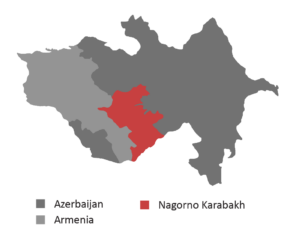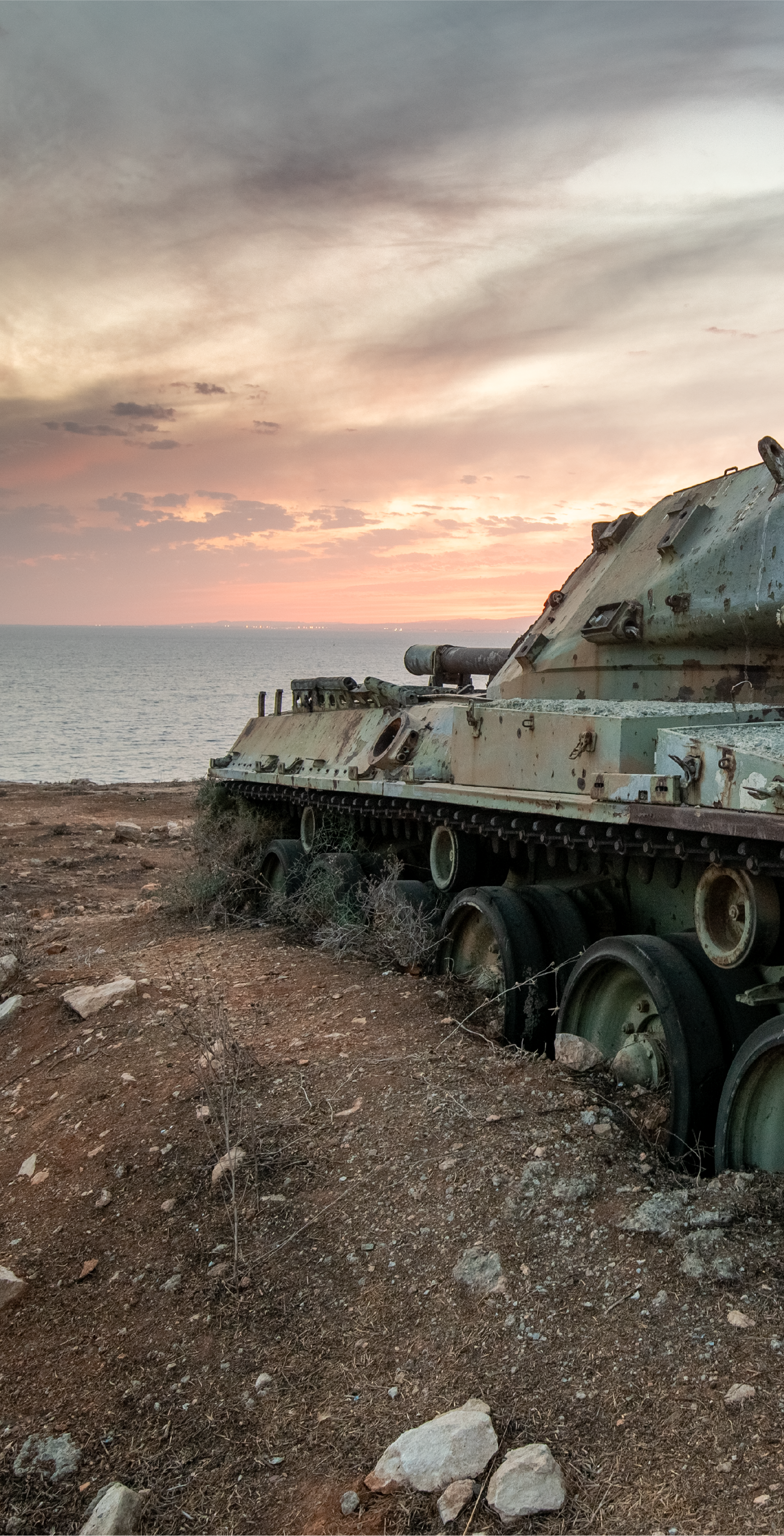Armenia and Azerbaijan’s political hostility over Nagorno Karabakh ignited in year 1988 and is commonly known as the modern phase of the dispute, while the collapse of the Soviet Union in 1991 additionally exacerbated the conflict into a territorial and ethnic war between both nations.
Namely, Nagorno Karabakh is located on the territory of Azerbaijan, however, has been populated by ethnic Armenians, with Baku always showing political aspirations to take full control of its territorial integrity. Violent tensions had flared up between both countries on many occasions, however the most violent clashes occurred in year 2020, with over 6,500 casualties in the six-week period of fighting. At the end of the bloody war, Azerbaijan celebrated its victory over Armenia which conceded defeat. Fast-forward to 2022, the brutal clashes have resurged with Azerbaijan’s aspirations of full territorial control of the Nagorno-Karabakh region growing stronger.
Therefore, if a permanent peace treaty is not signed, which would meet all the political goals of Azerbaijan, the armed conflict will not subside, in fact it will escalate even further until a complete military victory is achieved by Azerbaijan. If Armenia agrees to major concessions in the process of negotiations, it will possibly close the open question of Nagorno-Karabakh, however, it will trigger national unrest at home. Nevertheless, the most plausible scenario is that this conflict will not be resolved any time soon, as the political interests of Turkey and Russia will dominate in the dispute and will not allow an immediate halt of tensions.

In order to fully understand the stakes and relevance of the Nagorno-Karabakh war, one must first analyze the enormous potential of the disputed region. Namely, Azerbaijan has always sought the capacity of the Karabakh area that bears large economic benefits, being extremely rich in natural resources, such as gold and copper. It has been stated that only the gold mines Soyudlu or Zod (being positioned between Azerbaijan containing 76% and the rest belonging to Armenia) had a producing capacity of about 120 tons of pure gold in year 2010. Furthermore, it is not only gold and copper that has attracted both nations to this region, but also the rich water resources especially around the area of Sugovushan and Khudaferin. This is of essential importance for Azerbaijan as the country generates 25% of its water supply from this particular area.
Subsequently, this text will further analyze the main factors of the territorial dispute between Armenia and Azerbaijan including the inadvertent power struggle between Russia and Turkey for dominance in the Caucus region as well as the EU and US facilitated peace talks between the two arch enemies, Baku and Yerevan. The report will assess in full detail the main factors that determine the future steps and implications in this territorial dispute that represents a far more complex geopolitical game between powerful nations, each one fighting for their political interests at stake. The factors to be disseminated include Russian vs. Turkish level of involvement in the Nagorno-Karabakh war, acting out of political gain and as buffers in the conflict. Another factor to be considered is the signed ceasefires between both Armenia and Azerbaijan and their failed implementation, as the EU facilitated negotiations process for a permanent truce continues to yield no specific results. Finally, the mixed diplomatic and military strategy of President Aliyev disrupting the war and increasing the unpredictability of the final outcome. Additional factor evaluated is the role and political significancy of the so-called “Zangezur Corridor” that could prove to be the main game changer in the entire armed conflict.
01
A War for Political Dominance in the Caucasus: Russia Vs. Turkey
01
A War for Political Dominance in the Caucasus: Russia Vs. Turkey
The involvement of Turkey and Russia in the war conflict between Armenia and Azerbaijan only signifies that this dispute will not be resolved in the near future, as the main battle for geopolitical dominance continues in the area.
The regional clashes for Nagorno-Karabakh between the two neighboring countries have transformed into an open battle for supremacy over two historically arch enemies, Turkey and Russia who have meddled in the conflict defending their own political and economic interest in the process. This geopolitical clash has managed to further complicate the dispute between Armenia, which is supposedly under Russian protection and Azerbaijan, whose military has been sponsored and trained by Turkey, devoting years of strategy and army building in Azerbaijan. Turkey specifically has enormous economic stakes when it comes to supporting Azerbaijan, as a relevant export-import partner as well as its transit ally. In addition, the South Caucasus pipeline transports Azerbaijani gas from the Shah Deniz ground to Turkey.
However, what is even more interesting is the fact that Russia as well, appears as one of the top weapon suppliers to Azerbaijan.
Although Russia might be seen by others as playing a double game in the conflict because it also maintains a trade and gas partnership with Azerbaijan, representing a Foreign Direct Investor in Azerbaijani agriculture, Moscow traditionally considers Baku as its competitor, thus mainly focusing its support on Yerevan.
Subsequently, the current political status and geopolitical influence of both Russia and Turkey in the region delegates who will have the upper hand in the warfare between Armenia and Azerbaijan.
Furthermore, this continued war dispute in the Caucasus has only strengthened the level of political rivalry between Turkey and Russia, codependent on current events with the war in Ukraine and the geopolitical situation in the Middle East, increasing the relevance of the war in Nagorno-Karabakh to a completely new dimension.
Furthermore, with Russia’s military and strategic capacity focused on the war in Ukraine and its latest impediments in Kharkiv and Kherson as well as in other Ukrainian cities, protecting its Armenian ally is not on Russia’s list of priorities. Additionally, Russia’s reluctance to assist Armenia and affirmatively take its side is closely linked to two other factors. The first being, Russia’s skepticism towards the current political administration in Yerevan, which has been closely leaning to the Americans especially with Pelosi’s visit to the capital on 19 Sep 2022, has caused major concerns in the Kremlin. Second, allegations that the Armenian administration is attempting to secretly broker a deal with the West, threatening to remove Russian peacekeeping forces that have been positioned in the area of Nagorno-Karabakh since the latest escalation of the conflict in 2020, has alarmed the Kremlin.
If this supposed treaty occurs, it would be facilitated by the US, providing the West unrestricted entrance via Turkey to the Caspian Sea, opening a direct pathway for Western confrontation with Russia and Iran, making these two countries extremely vulnerable to political blackmail. Although Armenia denied such claims, Yerevan has been disappointed by Russia’s indifference and political inactivity, leaving its ally to handle the conflict by itself, with Azerbaijan and Turkey standing strong on the opposing front. All of these factors have prompted Armenia to look for alternative solutions and receive strategic US support in the war.
Azerbaijan on the other hand, decided to take advantage of Russia’s derailed focus and Armenia’s political weakness at the moment, managing to complete a memorandum of understanding with the European Union to increase gas exports to Europe for at least 20 billion cubic meters a year, a deal that should last until 2027. As Russia reduced its gas exports to Europe, Azerbaijan utilized in its favor EU’s serious demand for gas supply. Through such a strategic maneuver Azerbaijan automatically elevated itself as a relevant player on the regional and international scene, acting as the dominant force in the war with Armenia and attacking several cities near the area of Nagorno-Karabakh.
As Azerbaijan also continued to supply Ukraine with weapons, it simultaneously opened consultations with Russia to receive an ‘observer status’ in the Eurasian Economic Union (EAEU). Subsequently, Turkey’s increased diplomatic role in facilitating the grain corridor and deblocking the shipment of Ukrainian grain in the Black Sea, has elevated its political significance on the international stage. While Russia is engaged in a full-scale warfare in Ukraine, Turkey has positioned itself as a primary player in foreign affairs especially when it comes to Libya and Syria and the Caucasus, marginalizing Russia’s political influence in the region.
02
Broken Ceasefire and Failed Negotiations
02
Broken Ceasefire and Failed Negotiations
EU facilitated negotiations between Azerbaijan and Armenia have failed to bring permanent results or a lasting ceasefire between both nations, as tensions and violence surged in the region on 13 Sep 2022.
Almost two years ago, on 27 Sep 2020, Azerbaijan’s military force engaged in a direct offensive to seize full control of Nagorno-Karabakh and the 44-day war between Armenia and Azerbaijan began, where more than 6,500 people lost their lives. After Azerbaijan took over the town of Shusha in what was considered to be one of the deadliest battles, on 09 Nov 2020 Russia brokered a ceasefire agreement which was signed by the President of Azerbaijan, Aliyev and the Prime Minister of Armenia, Pashinyan as well as Russian President Putin. According to the deal, both nations would exchange prisoners of war, forcing Armenian military forces to draw back from their occupied territories in the region of Nagorno-Karabakh, which many interpreted as surrendering control to Azerbaijan. Russia on the other hand, stationed 2,000 of its soldiers as part of the peacekeeping mission on the border line, to ensure security for the next 5 years in the region. However, this signed ceasefire was short lived and the hostilities between both nations resumed, proving that the peacekeeping deal was poorly negotiated and not binding enough.

Namely, on 26 Aug 2022 the President of Azerbaijan, Aliyev had stated that his army was headed towards the city of Lachin (located on the strategic corridor that links Nagorno-Karabakh with Armenia) to push out Russian peacekeepers and seize full control of the disputed territory.
Shortly after the announcement, Azerbaijani soldiers waving the national flag took over the governance in Lachin replacing Russian troops. This political move by Azerbaijan only signified that the Russian brokered ceasefire had no political significance as the country moved forward with its military strategy and regaining back full territorial control of the region at stake. This failed agreement only minimized the value of ceasefire deals, where Azerbaijan militarily supported by Turkey and Israel as a trio alliance stood politically dominant against Russia, which attempted to assert its control in the region, however to no avail and with no positive outcome. Nevertheless, this failed peacekeeping deal also ushered a new sense of insecurity among Armenians who were heavily relying on Russia to administer peace in the region.
Fast forward to the present, EU has facilitated four rounds of mediation talks between leaders of Azerbaijan and Armenia, with the latest occurring on 31 Aug 2022 as a trilateral meeting including the President of the European Council, Charles Michel. During the meeting, Michel urged especially the Azerbaijani side to react on the issue of holding Armenian detainees and on the urgency of achieving a long-lasting peace treaty between both nations.
Although negotiations between Aliyev and Pashinyan seemed to have some form of progress, two weeks after the last brokered EU talks, Azerbaijan performed a military intrusion on Armenian territory on 13 Sep 2022. This invasion happened to be perfectly aligned in the same period when Russia suffered military losses on the territory of Ukraine.
Although Azerbaijan claimed that Armenia started the provocation, such allegations could not be substantiated. Amidst peace negotiations facilitated by the EU, another violent clash erupts in the region, killing almost 300 people, once again proving that these year-long discussions have failed to bring a long-lasting resolution to the ongoing problem between the two countries. It is possible that the EU negotiations did not yield a positive outcome because they lacked a more intense support and possible push from other international factors. After the violent clash, Russia brokered a temporary ceasefire, which represents a provisional deal, buying some necessary time and creating a political prolongment of the brewing territorial war in the South Caucasus that will escalate even further if not prevented beforehand.
Furthermore, on 19 Sep 2022, US Secretary of State, Blinken held a meeting with the Armenian Minister of Foreign Affairs, Ararat Mirzoyan and the Azerbaijani Foreign Minister, Jeyhun Bayramov in New York, amid the UN General Assembly. These represented the first direct talks between both nations after violent clashes escalated in the days prior to the meeting. And with this process of negotiations, the US officially became involved as a mediator in the conflict, attempting to ease hostilities and sustain the unstable ceasefire arranged by Russia, offering multilateral support to both nations.
Subsequently, on 27 Sep 2022 the US Department of State spokesperson, Ned Price, urged Azerbaijan to bring its military troops to their previous positions and pave the way for the establishment of a peaceful diplomatic atmosphere for the resolution of the conflict. He clearly stated that the use of violence and terror was not an acceptable solution for the US. It is yet to be seen whether the additional political push from the US in finalizing a peace treaty between Armenia and Azerbaijan will yield lasting positive results. So far, it appeared that none of the ceasefire agreements had long-lasting effects including the attempts from the EU to reconcile the arching enemies, escalating even further the war conflict.
03
The Mixed Diplomatic and Military Strategy of Aliyev
03
The Mixed Diplomatic and Military Strategy of Aliyev
President Aliyev has applied a mix of shuttle diplomacy in front of the EU and US in order to avoid international ostracization while executing a full military coercion strategy on Armenia, signaling that another violent clash is on the way.
It is first noteworthy to mention that Ilham Aliyev represents a rather intriguing and controversial political figure having absolute authority in Azerbaijan since being elected to office in 2003. His political actions were focused on strengthening his dynastic type of rule and tightening his political dominance, where in 2017 he appointed his wife Mehriban Aliyeva as the Vice-president of the nation which many people deemed as a highly authoritarian and scandalous move.
Continuing on with his political ambition of retaining back the lost territories within Azerbaijan, Aliyev carefully planned an offensive against Armenia for a long time. What was different during the 48 hours of violent clashes on 13 Sep 2022, was the fact that the conflict was no longer restrained to the enclave of Nagorno-Karabakh, rather the military of Azerbaijan had protruded deep into Armenian territory setting a precedent in the conflict so far. The government in Yerevan had claimed that Azerbaijan seized control of at least 10km of Armenian territory in an unprovoked aggression attack as Armenian authorities specified. The government in Baku denied all such allegations, first claiming that Azerbaijani military was protecting itself from Armenian soldiers who were to position mines on roads near the border line. Nevertheless, these claims were never justified by evidence.
In an attempt to present a more viable explanation for Azerbaijan’s military offense inside Armenia, President Aliyev stated that since there was no clear delineation of the border line, no one can strictly avow where the border lies, proudly asserting Azerbaijan’s military force and capability to take back its territorial integrity.
This statement clearly showcases the mixed diplomatic and military strategy that Aliyev implements, especially stressing in his speech that Azerbaijan has proven to the world that it is capable of redeeming its land by means of force and that the nation stands proudly of such acts.
Download Report
Armenia Vs Azerbaijan Beyond a Territorial War Dispute
What are the possible outcomes and future expectations with such a geopolitical chess game in the war conflict between Armenia and Azerbaijan?
After achieving a victory in the 2020 conflict and regaining back control of some of its territories, Aliyev invested in Azerbaijan’s military infrastructure and increased its political aspirations along the way. While asserting Azerbaijan’s military dominance in the region, Aliyev was strategically playing the international community focused on achieving two main objectives.
Though Azerbaijan’s latest and most intense military action against Armenia confused many, Aliyev took advantage of Russia’s focus on Ukraine and its inability to honor much of its bilateral defense treaty with Armenia leaving its ally vulnerable to attack. Therefore, the military action was definitely preplanned and premediated by Aliyev representing not only an assault on Armenia but also on Russian dominance in the region.
The goal was to showcase to the international community and Armenia that they cannot rely on Russia any longer, as Kremlin has its own political interests and priorities, slowly losing its grip in the region of Caucasus. Continuing with EU negotiations, the President of Azerbaijan fulfills his diplomatic duty of cooperating in front of the international community, while hanging on his military power as a primary tool of asserting Azerbaijan’s military supremacy over Armenia.
Many have wondered why Aliyev moves forward with international negotiations for a peace treaty while his military continues the offensive against Armenia. The mediation process facilitated by the EU and the US still represents a backup strategy for Aliyev securing him provisions that he cannot achieve so easily by means of force, due to their complicated political nature. Consequently, Aliyev hurried to continue the diplomatic talks in the US shortly after his military gained the upper hand in the war conflict. His goal was to politically extort from Armenia to reject any possible claims of Karabakh and agree to a new road route and connection across Armenian territory to the region of Nakhchivan, where Azerbaijan will be subjected to minimum security checks and regulations. Lastly, one of Azerbaijan’s important objectives is to settle through a written agreement with Armenia the demarcation of the border line, leaning in its favor and to its political interest.

Aliyev firmly believes that he has a political stronghold over Armenia both militarily and in the negotiations process. Especially after the President of the European Commission, Ursula von der Leyen had a working visit in Baku, with the goal of purchasing gas from Azerbaijan in July 2022. In her joint press conference with the President of Azerbaijan, Leyen referred to the country as a ‘reliable and trustworthy partner’ to Europe when it comes to mutual collaboration on many issues especially as an alternative gas supplier. However, she did not once refer to the ongoing conflict with Armenia nor publicly urge for the signing of a peace treaty. On the other hand, Aliyev recognized the need and urgency that Europe has from Azerbaijani gas, proclaiming this visit as a small victory for Azerbaijan when it comes to European support and having a more favorable position in the European peace talks.
Aliyev’s political strategy was to utilize the current geopolitical circumstances especially with Europe’s depletion of energy and Russia’s war in Ukraine, in order to gain significant advantages in the war conflict with Armenia. Meanwhile, Armenia has formally invoked Article 4 of the CSTO charter similar to NATO’s Article 5, however Russian hesitance and deafness towards Armenian pleas leaves room for new violent clashes in the region. Article 5 from NATO’s charter implying that when one member nation is under an armed attack, all allies will consider it as an act of aggression and react accordingly, represents a very dangerous invitation for a full-scale war between many nations.
Therefore, this article has always been taken with a dose of reservation and fear, carrying enormous political responsibility in itself. Although Armenia has urged Russia to apply Article 4 form the Collective Security Treaty Organization’s charter which represents the equivalent of NATO’s Article 5, the situation has not yet escalated to quite that level. Russia has attempted to mediate the conflict between Armenia and Azerbaijan and remain somewhat neutral in the entire territorial dispute, while diplomatically distancing itself from a bigger commitment towards Armenia. The Russian governed CSTO has evaluated the situation and has only issued a consultative response sending a monitoring mission in Yerevan led by the Secretary General of the organization, Belarusian Stanislav Zas, to assess the potential crisis.
However, in recent days Armenia has become very impatient and indignant due to CSTO’s inaction and refusal to provide militarily support to Armenia, after the nation accused Azerbaijan of directly threatening its territorial integrity on 13 Sep 2022. This makes Armenians extremely vulnerable to other possible attacks from Azerbaijan. During his UN General Assembly speech in New York, Armenian Prime Minister Pashinyan warned that the possibility of a new assault from Azerbaijan is an extremely plausible scenario, criticizing openly the CSTO for their failure to provide an adequate assistance and maintain regional security. The Armenian government is becoming extremely hesitant towards its cooperation with the organization, leaving the possibility for the country’s exit from the CSTO as a possible scenario. This will trigger Armenia to diplomatically incline towards the US for support and assistance. However, a potential exit might worsen Yerevan’s political and security position and additionally deteriorate relations with Russia, opening another battle front which definitely does not suit Armenia at the moment. Meanwhile, public protests have erupted in Yerevan, condemning the organization and its silence amid Azerbaijan’s aggression.
04
What to Expect Next
04
What to Expect Next
The intertwined political interests of many nations in the Nagorno-Karabakh war makes this conflict much more than a simple territorial dispute.
Therefore, future escalation of the war is closely interlinked with the political aspirations of Turkey and Russia in the region and whose political dominance would prevail. Azerbaijan is fully aware that it is militarily stronger than Armenia and is utilizing several geopolitical events as well as Turkish support to advance its position on the ground and on the negotiations table. Azerbaijan has managed to successfully insert its political relevance not only by negotiating a highly relevant gas supply agreement with the EU but has also played a double game in transferring arms to Ukraine at the same time while beginning the consultations procedure with Russia for receiving an ‘observer status’ in the Eurasian Economic Union (EAEU).
Such strategic moves have managed to give Azerbaijan an advantageous position in this entire scenario, ultimately gaining more political and military power to attack Armenia without bearing any political consequences for its actions.
However, not all is lost for Armenia. If the US becomes more deeply involved in the conflict and provides the needed assistance to Yerevan’s government, this war conflict will enter into a new dimension, definitely into a more complicated geopolitical dimension. Only, if Armenia does not agree to damaging concessions beforehand. Nevertheless, what are the possible outcomes and future expectations with such a geopolitical chess game in the war conflict between Armenia and Azerbaijan?
This question depends on how far Azerbaijan will go with its demands of political “proprietorship” and unrestricted access of the famously known “Zangezur Corridor.” If given full access through the signing of a specific peace treaty as Azerbaijan insists, the country will have unrestricted passage to Nakhchivan Autonomous Republic. This is also in the political interest of Turkey, as the corridor represents a large part in a highly relevant transportation development plan linking Baku and Istanbul. As President Aliyev stated when hosting Turkish President Erdogan in 2021 in the Zangilan district, this transportation corridor has the significance of linking the entire Turkic world together.
Nevertheless, this scenario so assertively pushed forward by both allies Turkey and Azerbaijan, could cause potential friction with Iran, threatening its political interest and territorial integrity in the region, as the corridor lies in the southern part of Armenia on its border with Iran. With a possible ceasefire agreement for opening the “Zangezur Corridor” Iran will lose its economic and transportation role, becoming vulnerable to Turkish and Azerbaijani dominance of the trade routes in the region. Iran is also aware that if Armenia loses control of its border line, Tehran will endure significant obstacles and restrictions when it comes to trade of Iranian products to Europe. Not to mention the potential threat from a pan-Turkic separatist upsurge in the northern part of Iran, as the country will be more easily exposed to Turkey’s political influence via the newly opened route. Acknowledging the fact that Iran could not bear to lose its share of political, economic and transit influence as well as territorial integrity in the region it might take a more proactive role in the entire conflict.
Furthermore, Russia plays and will continue to play a key role in the entire territorial dispute between Armenia and Azerbaijan. With its diplomatic silence in key moments of support for Armenia, Kremlin positions its political goals and aspirations in the forefront. Some of them align with Azerbaijan’s demands, one happens to be the opening of the Zangezur Corridor. In the ceasefire facilitated by Russia after the violent clashes between Armenia and Azerbaijan took place in 2020, it was stipulated that Moscow would seize control of this key strategic corridor, having immense political leverage and power especially over Turkey if in charge of this linkage route.
Therefore, Russia will further remain diplomatically neutral in the conflict, due to pre-calculated political interests, acting as a mediator if new tensions emerge between both nations, while cheering Armenia from the sidelines to appease public discourse. Meanwhile Azerbaijan supported by Turkey will continue to attend diplomatic talks seemingly interested in appeasement with Armenia and an end to the conflict while taking every opportunity to militarily provoke its neighbor and showcase its expansionist aspirations. The conflict between Armenia and Azerbaijan is far from over, leaving Yerevan in the middle of a major power struggle between Turkey and Russia.

ARTICLE | 19 PAGES




